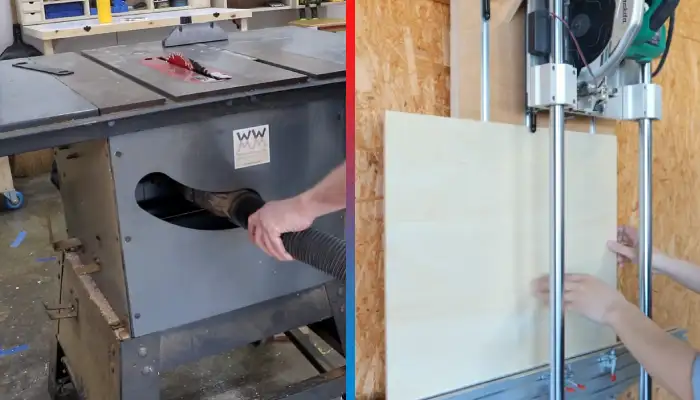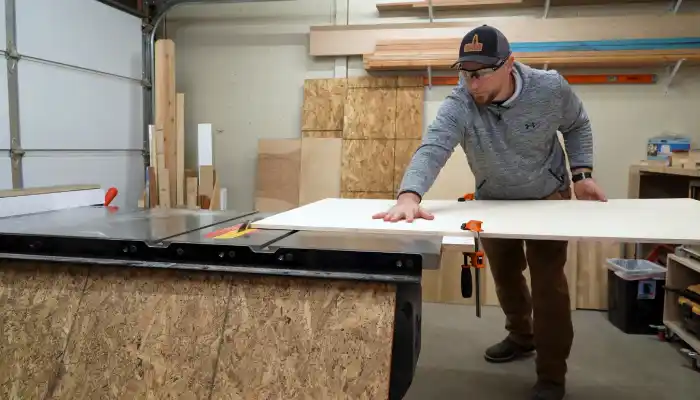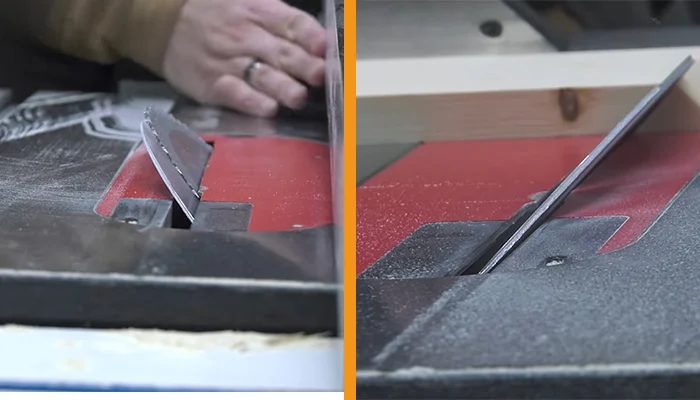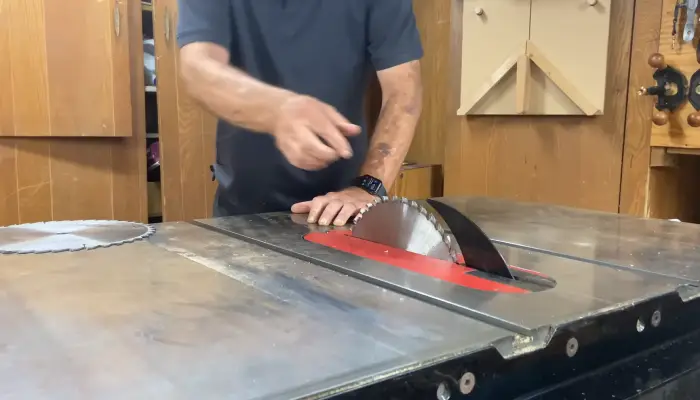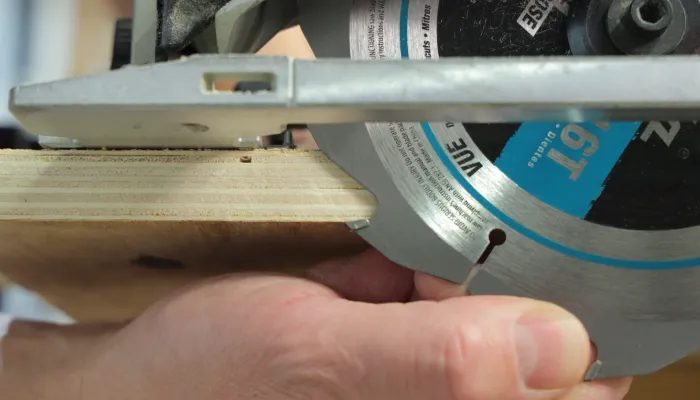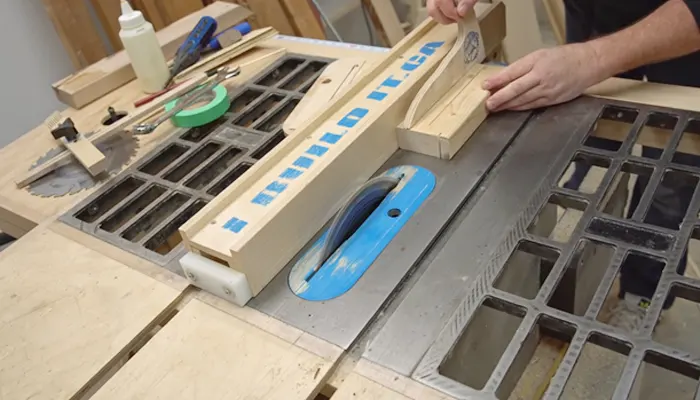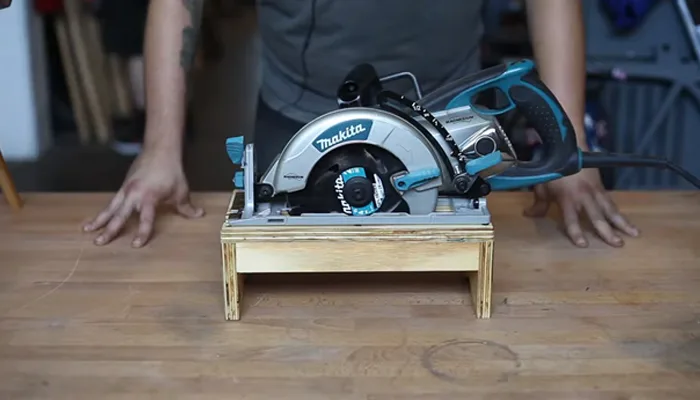Table Saw vs Panel Saw: 12 Key Differences
As a woodworking enthusiast, it caught my eye that people are arguing about whether a table saw or a panel saw is better for woodworking. After conducting extensive research and examining the features of both saws, I found several key differences between these two power tools that every woodworker should know.
The first is panel orientation, as table saws are designed for cutting smaller pieces while panel saws are optimized for cutting large sheets. Also, space requirements should be considered, as table saws typically require a dedicated area in a workshop, whereas panel saws can be wall-mounted or freestanding.
As part of this article, I’ll discuss the differences between these two essential woodworking tools. If you’re wondering why you would use a panel saw or if you can rip with it, I’ll explain those questions too.
- Compact 8-1/4 Inch Design
- Precision Rack & Pinion Fence
- Advanced Site-Pro Guarding System
- Robust Metal Roll Cage
- Efficient Dust Port Design
- Powerful 3HP Worm-Drive Motor
- Solid One-Piece Steel Frame
- Efficient Dual Dust Collection Ports
- True Counterweight System for Stability
- Smooth Carriage Glide on Stainless Steel
Differences Between Table Saw and Panel Saw for Woodworking
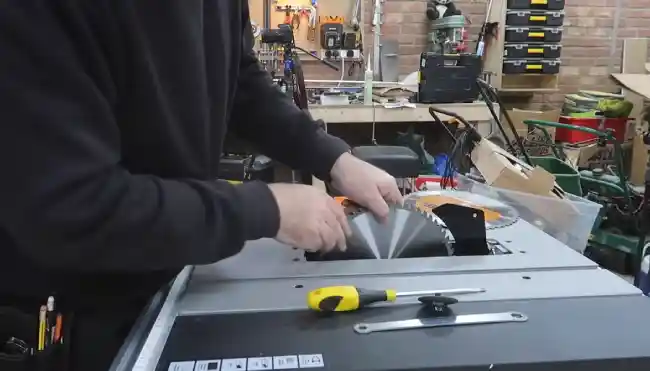
When comparing table and panel saws for woodworking, I have found several key differences.
- Panel orientation
- Space requirements
- Handling large sheets
- User safety
- Precision and specialized features
- Portability
- Cutting length
- Time efficiency
- Dust collection
- Blade exposure
- Versatility
- Saw cost
1. Panel Orientation
Panel orientation refers to how the workpiece or material being cut is positioned about the saw blade.
Table saws are typically used with a horizontal panel orientation, where the workpiece lies flat on the table and moves across the blade. This orientation allows for a wide range of cutting tasks, such as rip cuts, crosscuts, and bevel cuts, as the blade is oriented vertically and protrudes from the table.
Conversely, panel saws are designed for vertical panel orientation. This means large sheet materials, like plywood and OSB, stand upright against the vertical table. This orientation is particularly useful for quickly breaking down large sheets into smaller, more manageable pieces.
2. Space Requirements
Table saws are known for their practicality in small home workshops due to their ability to fit into a limited space. These saws are designed to be compact and versatile, making them an excellent choice for those with limited workspace.
Alternatively, panel saws are more suited for large-scale operations and may not be as space-efficient as table saws. Their size and design make them less ideal for smaller workshops where space is at a premium.
While panel saws can be equipped with extensions or outriggers to handle larger sheets, they still require much floor space, making table saws more compact for woodworking.
3. Handling Large Sheets
Panel saws are specifically designed for efficiently handling large sheet materials. With their vertical orientation and dedicated sliding carriage, panel saws provide excellent stability and control when cutting through large sheets.
This makes them the superior choice for tasks that involve working with substantial pieces of wood, ensuring accurate and safe cuts while maintaining efficiency in the woodworking process.
In contrast, table saws, although versatile, may struggle with the size and weight of large plywood sheets. Additional supports or a track saw can help address this limitation, but it can still be a challenging task.
4. User Safety
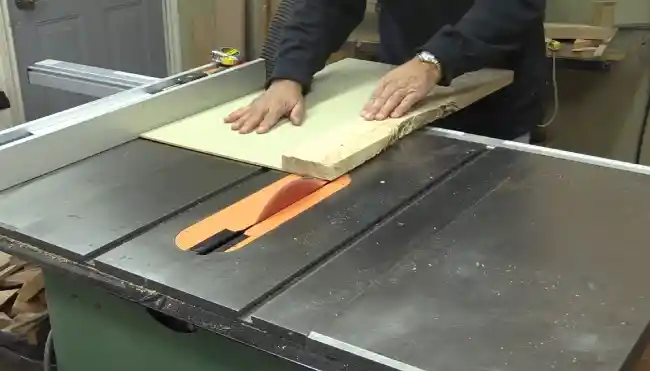
From my observations, the user safety advantages of a panel saw over a table saw are significant. One of the main reasons is the table feature of a panel saw, which minimizes direct contact. This greatly reduces the risk of accidents, especially when handling large sheets of material.
With a table saw, the operator needs to manually push the material through the blade manually, increasing the chances of accidental contact and potential injury. Additionally, panel saws often have built-in safety features such as blade guards and emergency stop buttons, further enhancing user safety.
5. Precision and Specialized Features
Table saws can offer high precision for various cuts. Still, they may not match the accuracy, repeatability, and specialized features (such as beveled cuts, non-square panel cuts, dados, and rabbets) that sliding table saws provide.
Specialized panel saws are known for their precision, repeatability, and ability to handle complex work. Woodworkers highly value them for their precision and specialized capabilities.
6. Portability
Table saws are known for their relatively high level of portability. With their compact size and wheeled bases, they can be easily moved around the workshop or even transported to different job sites. This makes them ideal for on-the-go projects and ensures that woodworkers can work efficiently in various locations.
On the other hand, panel saws, especially industrial-grade models, are typically heavy and less portable. They’re designed for stationary use within a workshop or factory, making them less suitable for jobs that require mobility.
7. Cutting Length
Although table saws and panel saws are both used for woodworking, there’s a significant difference in their cutting length capabilities. Table saws are limited by the size of their table and rip cut capacity, making them less suitable for cutting very long boards or sheets without additional support.
Alternatively, panel saws excel in handling long sheets and boards due to their large sliding tables. These sliding tables offer extended cutting lengths without the need for extra support. Panel saws are specifically designed to handle larger materials, allowing woodworkers to make precise cuts on long pieces with ease.
8. Time Efficiency
When it comes to smaller, intricate cuts and tasks that require frequent adjustments, a table saw is the way to go. With its precision cutting capabilities and ability to handle intricate joinery, the table saw excels in these areas.
However, if you need to break down large sheets quickly, a panel saw is the better choice. It’s highly efficient in handling substantial quantities of sheet materials, making it ideal for production-focused projects.
The panel saw saves valuable time by swiftly cutting through large sheets, allowing for increased productivity and efficiency in woodworking projects.
9. Dust Collection
When comparing the dust collection capabilities of table saws and panel saws for woodworking, one noticeable difference is the integration of dust collection systems.
Table saws typically come equipped with integrated dust collection systems, which are designed to keep the workshop cleaner and safer. These systems often feature a dust port beneath the blade, allowing for efficient extraction of fine dust particles.
Meanwhile, panel saws may have limited dust collection systems, as they’re primarily designed for handling large sheets and may not prioritize fine dust extraction. As a result, additional dust management measures may be necessary for maintaining a clean and healthy workspace when using a panel saw.
10. Blade Exposure
As I continue discussing the differences between table saws and panel saws for woodworking, it’s important to highlight the variation in blade exposure between the two types of saws.
Table saws typically have exposed blades, which require careful handling to avoid accidents. You must exercise caution and may need additional safety features such as blade guards to minimize the risk of injury.
In contrast, panel saws have less exposed blades. The sliding table design provides added safety by minimizing direct contact between you and the blade. This reduces the chances of accidental contact and enhances overall safety in the woodworking process.
11. Versatility

Table saws are incredibly versatile tools that excel at various woodworking tasks. They’re capable of ripping narrow strips, making bevel cuts, creating dadoes, and forming tenons, among other functions. This adaptability makes them a go-to choice for many woodworkers.
On the other hand, panel saws are more specialized, primarily designed for quickly breaking down large sheet materials like plywood and OSB. However, they’ve limitations when making angular cuts and working with smaller pieces of plywood.
12. Saw Cost
Regarding cost, the table saw is the more affordable option for woodworkers on a budget. A good cabinet saw can be purchased for around $2,000 to $3,000, making it a much more economical choice than the panel saw.
Alternatively, panel saws are more expensive, starting at around $1,800 and potentially exceeding $10,000 for industrial-grade models. The higher cost of panel saws can be attributed to their specialized and large-scale applications, which may not be necessary for all woodworking projects.
Table Saw vs Panel Saw: Comparison Table
| Feature | Table Saw | Panel Saw |
| Versatility | Versatile, handles various tasks | Specialized for large sheet material cutting |
| Space Requirements | Practical for small workshops | Space-efficient, more suitable for larger shops |
| Handling Large Sheets | May struggle, additional supports may be needed | Efficient, designed for handling large sheets |
| Safety | Safety risks due to exposed blade | Safer with sliding table design |
| Precision & Features | Precise cuts, versatile features | High precision, specialized features |
| Portability | Relatively portable, suitable for job sites | Less portable, designed for stationary use |
| Cutting Length | Limited by table length and rip capacity | Extended cutting lengths without support |
| Bevel Cutting | Versatile for a wide range of bevel angles | Less versatile for bevel cuts |
| Time Efficiency | Efficient for smaller, intricate cuts | Highly efficient for breaking down large sheets |
| Dust Collection | Integrated dust collection systems | Limited dust collection, may require extras |
| Blade Exposure | Exposed blade requires careful handling | Less exposed blade with sliding table design |
Can a panel saw replace a table saw?
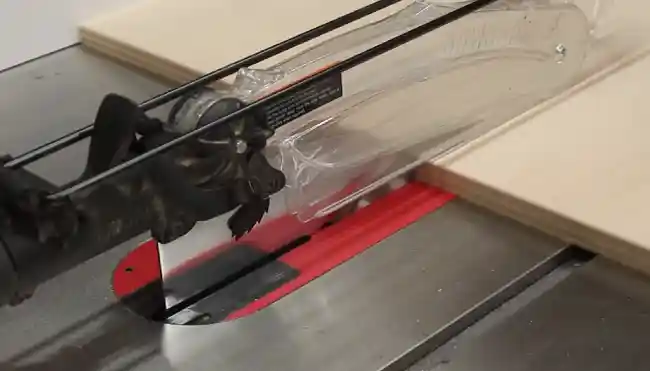
The versatility of a panel saw makes it a viable alternative to a table saw for various cutting needs. While a table saw is commonly used for cutting smaller pieces of wood, a panel saw is specifically designed to handle large sheets of material like wood, MDF board, and plastic.
With a panel saw, there’s no need for a second person to assist in lifting heavy sheets onto the saw, as the saw itself is designed to handle the size and weight of these materials. Also, panel saws often have features like a scoring blade, which further enhance their capabilities for cutting large sheets accurately and efficiently.
Why would you use a panel saw?
For cutting large sheets of material accurately and efficiently, I recommend a panel saw. Unlike a table saw, which requires the user to guide the material through the blade manually, a panel saw has a sliding carriage that holds the material securely in place. This ensures precise and straight cuts, eliminating the risk of human error.
Also, panel saws are designed to handle large sheets, such as plywood or MDF, which can be difficult to maneuver on a table saw. The sliding carriage also allows for faster cutting speeds, increasing productivity and saving time.
Can I RIP with a panel saw?
When using a panel saw, ripping large sheets of material is achievable due to its sliding carriage and precise cutting capabilities.
Unlike a table saw, which requires the material to be fed through the blade, a panel saw allows it to remain stationary while the blade moves across it. This is made possible by the sliding carriage, which provides smooth and controlled movement.
Also, panel saws often have a riving knife that trails the blade to support the cut-off piece, ensuring clean and accurate cuts. The combination of the sliding carriage, precise cutting capabilities, and the inclusion of a riving knife make panel saws a suitable option for ripping large sheets of material with ease and precision.
Do I actually need a table saw?
My personal opinion is that owning a table saw is essential for woodworking projects. While it’s true that woodworking can be done without one, the table saw offers unmatched precision, efficiency, and versatility.
With its adjustable fence and blade height, the table saw allows for accurate and consistent cuts, whether ripping, crosscutting, or making angle cuts. Also, its powerful motor and stable work surface enable you to work with a wide range of materials and tackle larger projects with ease.
What is a table saw best used for?
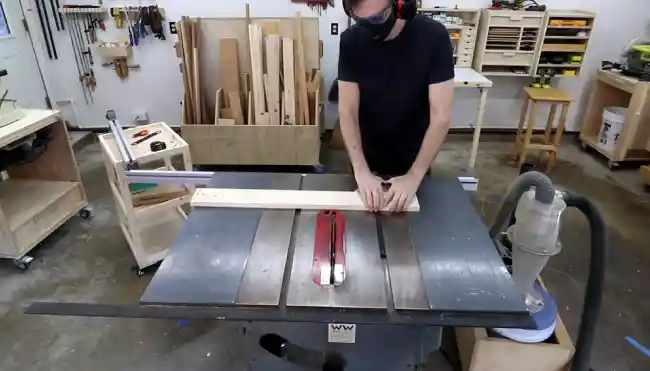
Table saws excel at making straight cuts on small and longboards, ensuring cleaner and smoother results compared to handheld or machine saws. Whether you’re working on DIY projects or professional woodworking, the table saw’s ability to cut precise angles and widths makes it indispensable.
It’s perfect for ripping boards, crosscutting, mitering, and creating dado cuts. Additionally, with the right accessories and attachments, a table saw can be used for joinery work, making tenons, and even shaping wood.
Table Saw or Panel Saw: Choose the Perfect Saw for Woodworking
After analyzing the various features of a table saw and panel saw, it is evident that both have their unique strengths and weaknesses. However, according to my study, the choice between a table saw or a panel saw depends on individual preferences based on woodworking requirements.
Therefore, consider factors such as space availability, cost, precision, and specialized features that may vary from one tool to another.
It’s vital not to overlook user safety, motor power, and handling large sheets, which are critical considerations when purchasing. I hope this article has provided useful insights.
- Powerful 15 Amp Motor
- Versatile 10-inch Carbide Blade
- Precision Rack and Pinion Fence
- Durable Construction for Stability
- User-Friendly Portable Design
- Portable 5′ Frame for Mobility
- Industrial 3.25 HP Motor
- Adjustable Vertical and Horizontal Rulers
- Quick Change Vertical to Horizontal
- 64″ Max Crosscut Capacity
Last update on 2025-07-09 / Affiliate links / Images from Amazon Product Advertising API

